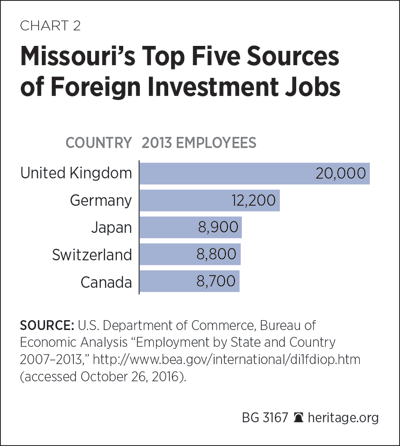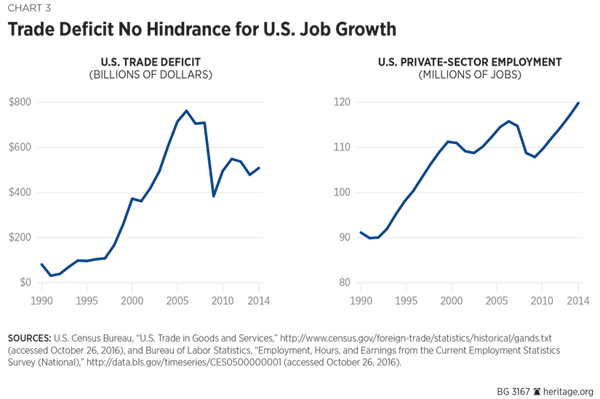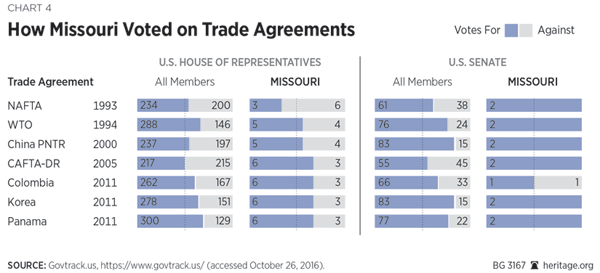International trade and investment supports more than 800,000 jobs in Missouri, representing nearly a quarter of overall employment in the state. Businesses in Missouri, especially automotive suppliers, depend on affordable imports to increase their competitiveness in the international market. Foreign direct investment in Missouri actually supports more jobs than goods exports.
Given trade’s valuable contributions to Missouri’s economy, support for policies that preserve or enhance Americans’ freedom to trade has grown among the state’s congressional delegation. While two-thirds of Missouri’s Representatives voted in favor of the Panama, Colombia, and Korea trade agreements, there is still room to improve the delegation’s support for Americans’ freedom to trade.
Trade agreements lower or even eliminate tariffs or non-tariff barriers for all countries involved, creating a more open market for exchanging goods and services, but agreements are not the only way to enhance Americans’ freedom to trade. The U.S. government can also unilaterally eliminate tariffs and other barriers to trade. In Missouri, elected officials could support their constituents’ freedom to trade by embracing policies that increase product choices and reduce prices, such as unilaterally eliminating tariffs on all intermediate goods.
Exports Boost Missouri’s Economy
Goods exports from Missouri were valued at $13.6 billion last year. Approximately 6,000 companies in Missouri export goods outside the U.S. each year; 85 percent of these companies were small or medium-sized businesses. In 2015, 87,927 Missourians owed their jobs to goods exports.[1] Missouri’s service exports, valued at $8.9 billion in 2014, have grown by 77 percent since 2006.[2]
Missouri’s top five export industries are transportation equipment, chemicals, machinery, processed foods, and electrical equipment. The largest industry, transportation equipment, exported approximately $3.1 billion in goods in 2015, and three of the remaining top five industries exported more than $1 billion in goods. The state’s top five export markets are Canada and Mexico (with which the U.S. has a free trade agreement), as well as China, Japan, and Germany. Three-fifths of Missouri’s goods exports went to America’s 20 free trade partners.[3]
Chemical Manufacturing: A Growing Missouri Industry
Chemical manufacturing, Missouri’s second largest export industry, has experienced significant growth in recent years. Last year, exports in this industry were valued at $2.6 billion, up 5.5 percent from 2014.[4] Growth in chemical exports was largely fueled by two sub-sector industries: pharmaceuticals and medicines, as well as soaps, cleaning compounds, and toilet preparations, which grew by 10.8 percent and 18.9 percent, respectively.[5] Missouri’s top three chemical export markets in 2015 were Canada, Germany, and Belgium.[6]
Changes in Missouri’s chemical manufacturing industry have been evident in more than just export growth. Chemical manufacturers employ more than 18,000 Missourians, and the sector exceeded pre-recession employment levels in 2013. The aforementioned subsectors saw the highest export growth in 2015 and have also experienced the highest employment growth since 2011, 12.2 percent and 18.7 percent, respectively.[7]
Missouri Businesses Need Competitively Priced Imports
In 2015, Missouri imported approximately $18.5 billion of products, which were primarily from China, Canada, and Mexico. Imports from Canada and Mexico, both partners in the North American Free Trade Agreement (NAFTA), were valued at $6.6 billion, representing over one-third of total Missouri imports. These imports, many of which are intermediate goods, range from large piston engines to ignition wiring used for manufacturing aircrafts, cars, and ships.[8]
Imports strongly support the state’s manufacturing industry, which employs approximately 261,500 Missourians.[9] A majority of the top 25 imports are used in manufacturing aerospace and transportation equipment, the two largest advanced manufacturing sectors in Missouri. Imports of intermediate goods used in chemical and related industries have also increased since 2014.[10]
Imports allow Missouri companies to purchase the materials they need at lower prices, decreasing production costs. Missourians feel these savings directly at their local stores, where they can purchase diverse, high-quality, and cost-effective products. The Council of Economic Advisers recently noted that trade “is especially important for middle-class consumers who spend a larger share of their disposable income on heavily-traded food and clothing items…. [M]edian-income consumers gain an estimated 29 percent of their purchasing power from trade.”[11]
Foreign Direct Investment Supports Missouri Jobs
Foreign direct investment, the exchange of capital rather than the exchange of physical goods, is often overlooked when examining the benefits of trade. However, 104,300 Missourians were employed by foreign-owned companies in 2014, representing just over 4 percent of total private-sector employment in the state. For Missouri, jobs supported by foreign investment actually exceed jobs supported by goods exports.[12]
Several foreign companies have announced new or additional investment projects in Missouri over the past year. NRGene, an Israel-based company and leader in genomic big data, announced earlier this year that it would place its U.S. headquarters in St. Louis, Missouri. The company is known for developing tools and models for farmers and animal breeders. According to Gil Ronen, CEO of NRGene, “Missouri as the ‘Heartland’ of American agriculture is the natural U.S. home for NRGene.”[13]
Brodrene Hartmann, a Danish-based company and the world’s largest manufacturer of molded-fiber egg packaging, began construction to increase the size of its facility by 20,000 square feet this year. The company’s expansion will add approximately 50 new jobs by 2017.[14]
SubTropolis: An Innovative Location for Foreign Companies
Since 1964, Kansas City businesses have been taking advantage of an innovative underground industrial park. Now called SubTropolis, the world’s largest underground business complex is a repurposed limestone mine containing millions of square feet of temperature-controlled space. The facility is home to more than 50 businesses ranging from warehouses to automotive assembly plants.[15]
Grupo Antolin, a Spanish company and the world’s top manufacturer of vehicle headliners, recently signed a lease for 36,000 square feet of space in SubTropolis. The company, which employs about 300 people in the Kansas City metro area, chose to expand its operation in SubTropolis “because it has a wide range of warehousing options as well as superior climate control, round-the-clock security and affordable operation costs. The number one consideration, however, was location.”[16]
Trade Deficit Not Responsible for Private-Sector Job Losses
Trade skeptics often claim that America’s growing trade deficit, especially with China, has a negative impact on U.S. jobs, or even causes job loss.[17] Despite the misleading connotations attached to this term, a trade deficit means simply that the value of U.S. imports exceeds the value of its exports. However, trade is not solely made up of imports and exports. Once financial transactions like foreign direct investment are taken into account, any imbalance disappears.
The numbers simply do not support the assertion that the trade deficit causes job loss, as shown in Chart 3. Since the implementation of NAFTA in 1994, the overall U.S. trade deficit has increased, mostly due to an increase in goods imports. In terms of services, however, the United States actually had a trade surplus of more than $230 billion in 2014.[18] Meanwhile there has been a net increase in private-sector jobs in America since NAFTA, many resulting from foreign direct investment.
Trade and innovation create economic opportunities in some sectors while employment in less-efficient sectors can decline. Based on applications for Trade Adjustment Assistance, 1,652 Missourians could show some link between trade and their job loss in 2015.[19] However, there has been no net job loss in Missouri due to trade with China or any other country. Since NAFTA, Missouri has added 265,900 private-sector jobs.[20]
Missouri Legislators on Free Trade
As demonstrated in Chart 4, Missouri’s elected officials increasingly support the freedom to trade. In 2011, six of nine Representatives voted for trade agreements with Colombia, Korea, and Panama. Both Missouri Senators supported the Korea and Panama agreements, but their votes split on the Colombia agreement. In contrast, support for NAFTA in 1993 was weak in the Missouri delegation; only three Missouri Representatives voted in favor of it, though both Senators did support it.
Missouri’s elected officials are acknowledging that the freedom to trade benefits all Missourians through their support for these agreements. They also recognize that advanced manufacturers in Missouri depend on innovative and competitively priced intermediate goods to produce final goods, as well as the ability to freely sell their products around the world.
The Sky Is the Limit for Missouri
Missouri is positioned to experience substantial benefits from trade. In order to sustain and increase economic prosperity for all Missourians, the state’s elected officials should support policies that reduce barriers to trade and investment and work to strengthen support for policies that expand Americans’ economic choices.
—Tori K. Whiting is Research Assistant in the Center for Trade and Economics, of the Institute for Economic Freedom and Opportunity, at The Heritage Foundation. Maria Nenkova and Sarah Nielsen, participants in The Heritage Foundation’s Young Leaders Program, made valuable contributions to this Backgrounder.






